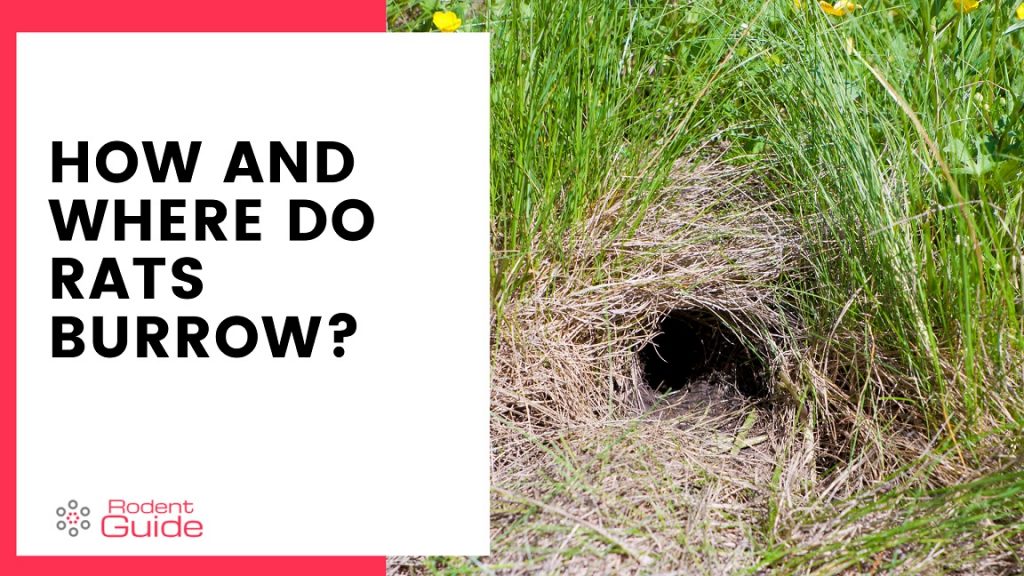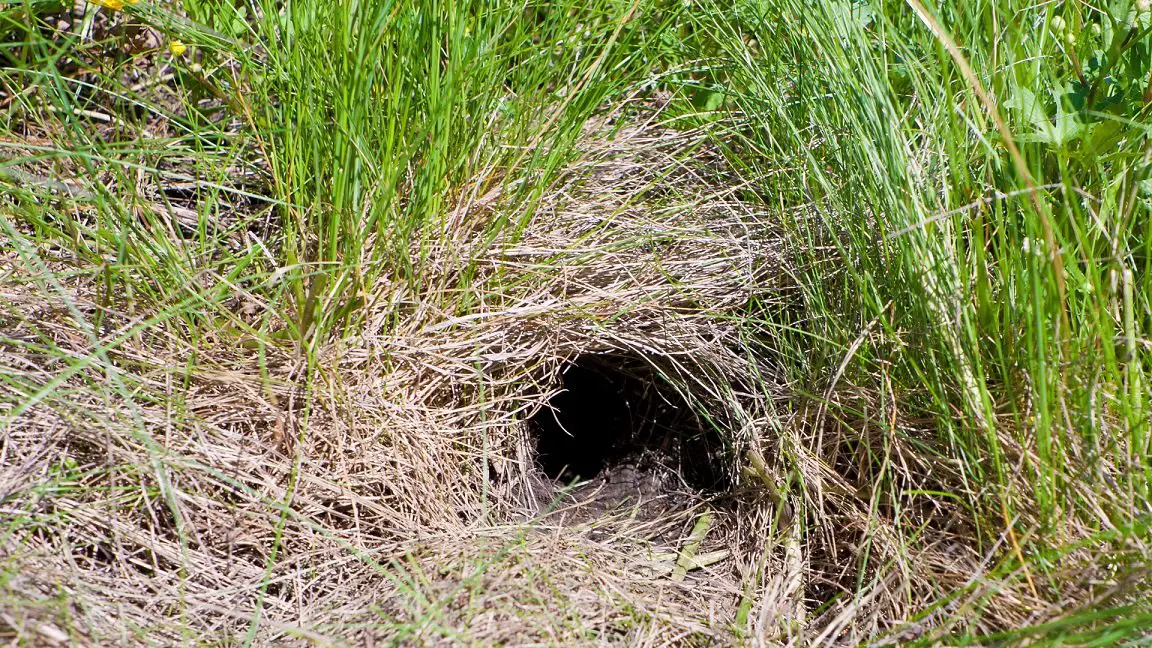Rats. They seem to appear around your property, don’t they? While that is (sometimes) true, as rats are opportunistic creatures, it may also be because there is a burrow near your home.
As rats are dangerous, you will want to put a stop to this. In this post, we will cover some of the questions you may have about rats and their burrows.
Questions like; Where do rats burrow? What does a burrow look like, and how can I get rid of a rat burrow.
What you will learn in this post:
- What a rat burrow looks like
- How you can destroy a rat burrow
- Where do rats burrow

Do Rats Burrow?
Let’s start with the obvious question and a short answer. Do rats burrow?
Yes – rats do burrow. The burrows host a nest for the birth of even more rats.
Rats are incredible breeders! For this reason, the best option is to destroy the burrow ASAP.
Where Do Rats Burrow
We will take a look at 5 places that are common for a rat to set up a burrow. Where do rats burrow? Let’s take a look.
In Overgrown Areas
Rats like to operate in covered areas. They do not want to be seen as they enter and exit their burrow.
For this reason, the entrance to the burrow and all the exits are most likely to be created in areas covered by bushes, trees, or other objects.
Under Concrete
While rats will burrow under concrete, it is unlikely that the entrance to the burrow is in the concrete.
A rat’s burrow is only usually 1 or 2 feet deep, but they will go down further if needed.
In terms of borrowing under concrete, this will offer rats additional protection.
Under Rocks
Rocks are similar to concrete – they offer protection for each entrance and exit point from the burrow.
When looking for the entrance to a rat burrow, you should look around large rocks or an extensive collection of rocks.
Under Your Home
A rat burrow could potentially be apparent under your home, which has the potential to cause structural damage to your home and also offers a rat an opportunity to get inside your home.
A rat might use this as an entry point to your home! Once they are in, they are a health hazard.
In Your Garden
Rats need food. It is one of the things that attract a rat to your home.
Your garden will allow a rat to eat the plants, vegetables, and fruit growing in your garden.
Rats sometimes dig underneath root vegetables for easy access to food. If you have seen a rat in your garden, it is worth checking on anything that you are growing.
What Do Rat Burrows Look Like?
The entrance to a rat burrow will be a hole between 2 and 4 inches across. Underneath the entrances will be a series of tunnels leading to an area underground where they will build the rat nest.
How Deep Are The Burrows
Rats have been known to burrow 11 feet deep. Most rat burrows are only 1 or 2 feet deep.
Rats usually dig their burrows deep only when they need to avoid structure, such as the foundations of your house.
How Can You Get Rid Of A Rat Burrow

Use A Hose
This method involves a hose and a lot of water! Place the hose in the entrance to the rat burrow, and let the water flow!
If you have found the exits, you might want to consider covering those if you don’t want the rats to survive. For example, rats can survive underwater for up to 3 minutes.
This is my go-to method for getting rid of a rat burrow.
- Place the hose into the burrow entrance
- Turn the water supply on
- Once complete – I will dig up the tunnel system to destroy it (More on that below)
Use Bleach
You could pour bleach into the entrance to the burrow. This will deter the rats from going into the burrow and kill any rats that ingest it.
Bleach is an excellent weapon in your battle against rats! Not only will it deter the rats, but it can also kill them (if it is ingested). Bleach is also a cleaning agent you can use to clean up rat urine that has the potential to cause harm to you and any pet you have.
Bait The Burrow
You could bait the burrow with poison or place some poison inside traps that will keep the rats captured until the poison takes effect.
I am not a big fan of using poison for rat control due to the secondary poisoning risks (such as a bird eating a poisoned rat).
When the rats exit the burrow, they will be attracted to the rat bait and captured in a trap.
Dig Them Out
You could go on a full-out attack on the rat burrow! This is something that I always do once I am confident that most or all of the rats have left. Dig it up!
All you need to do is use gardening equipment to dig up the burrow. This depends entirely on where the burrow is. For example, if the tunnel system is under your home or concrete, I will flush them out with water.
Clear The Surrounding Area
One of the most important things you can do is clear the area around the burrow.
Rats prefer to operate in areas where they cannot be seen and will use the cover of an overgrown yard to get close to your home.
Clearing your yard makes you less likely to see a rat or a rat burrow.
Frequently Asked Questions

How do you get rid of a rat burrow?
I prefer to place a hose inside the entrance and turn the water on! Eventually, you will notice rats exiting the burrow through one of the exits they have built. In my experience, the rats do not return to that burrow, but it is a good idea to fill the holes or dig up the burrow. They are not usually very deep (1-2 feet).
What does a rat burrow look like?
The entrance is the only part of the rat burrow that you will see unless you dig further down. The entrance will be a hole that is 2-4 inches wide. There will also be at least 1 exit hole created just in case they need to make a hasty escape. Underneath the entrance will be a series of tightly packed tunnels and at least 1 area to build a nest.
Can rats burrow through concrete?
Although rats can chew through concrete (there are exceptions to this), they are unlikely to build an entrance to a tunnel by going through concrete. Instead, a burrow entrance may be close to concrete for additional security. The tunnels and nest chamber could also be under the concrete. Again, for some extra protection.
Should I block up a rat hole?
Rats are naturally burrowing creatures and often create holes in yards or gardens to create their nests. If you find a rat hole on your property, you may wonder if you should block it up to prevent the rats from returning.
There are a few things to consider before taking action. First, determine how active the hole is. For example, if you see rats coming and going from the hole, there is likely an active nest, and blocking the hole could cause problems. For example, the rats may become trapped inside and die, creating a nasty smell. Additionally, if the rats cannot escape, they may chew through walls or other surfaces to get out, causing damage to your property.
If the hole is not active, you may decide to block it up. You can do this with various materials, such as concrete, bricks, or rocks. Be sure to fill the hole and pack the material tightly so rats cannot tunnel their way back in.
What can I fill a rat hole with?
You can fill a rat hole in many ways to prevent them from returning. Some common methods include:
- Filling the hole with dirt or sand
- Filling the hole with concrete, bricks, or rock
- Filling the hole with steel wool
- Plugging the hole with a rubber stopper
Which method you choose will depend on the location of the hole and your personal preference. Whichever method you choose, ensure the hole is filled so that rats cannot dig their way back in.
Can you flood a rat burrow?
You can flood a rat burrow by filling it with water. This will drown the rats or force them to leave the area, searching for drier ground. You can also use this method to flush out other pests, like moles that may be living in the burrow.
Conclusion
We have identified 5 common places for a burrow in this post and 5 ways you can destroy it! Do rats burrow? We’ve answered that too.
Rats carry many nasty diseases that can transmit to humans and other animals. They are also very destructive and can breed at a lightning-fast rate!
For those reasons, you need to address any rat related issue that you have in and around your home.
Now that you have addressed the problem with the rat burrow, you need to prepare for another invasion. If rats have set up a home near your home, it is a warning. You need to seal up rat entry points immediately. This is the most effective way to ensure they do not enter your home.
Good luck!








